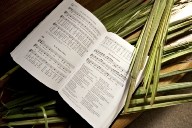Every small child gets bored at Sunday services. I was no exception. But every year, one Sunday always left an indelible imprint in my mind — Palm Sunday.
As parishioners walked through the main doors, they had to pass a table loaded with palm fronds. Wafting around was the palm’s delicate scent, a natural elixir of relaxation.
Everyone was encouraged to pick up a silky smooth palm branch, usually with several fronds each. As the service progressed, people would sit in their pews weaving the fronds into crosses, flowers and baskets.
While sitting in a crowded pew flipping the palm from side to side, the delicate scent would float through the air. My imagination would drift off to Palestine and that day when, according to the New Testament, Jesus, sitting on a donkey, rode through the East Gate of Jerusalem to cheering crowds that covered the road with palm branches.
Palm branches symbolized triumph and victory in pre-Christian times. Romans rewarded champions and celebrated successful military campaigns with palm branches.
At the time of Jesus’ entry, many Jews had converged in Jerusalem to celebrate Passover, a festivity that commemorated the Exodus in which ancient Israelites were freed from slavery in Egypt.
“More than any other time, there was strong expectation of a Messiah and if there was going to be a Messiah, this was it,” explains Reverend James Ravenscroft of St. Albert United Church. “They were expecting Jesus was going to be a liberator. Some people thought he was the anticipated person that would free them from the bonds of Rome.”
Father Andrzej Stendzina of St. Albert Catholic Parish compares the ancient strewing of palms to the cushy ‘red carpet’ modern society rolls out for important people.
“He was recognized as a special person and many thought Christ would gather an army and kick out the Roman army. But instead he came to touch people’s hearts.”
The palm has a long history of popping up in Middle Eastern cultures. In Assyrian mythology, their sacred tree is a palm that symbolizes Ishtar, the goddess of fertility, linking heaven (the crown of the tree) and earth (the tree’s foot). Ancient Egyptians related palm stems to long life and the palm tree was a sacred sign for Greek god Apollo.
In Judaism, the date palm is one of four species used in daily prayers at the feast of Sukkot. And in Islam, it is said that Muhammad built his home using palms. As a result, many areas of the Middle East consider the palm a symbol of rest and hospitality.
Early Christians viewed the palm as a symbol of victory of the faithful over the enemies of the soul and it led to churches distributing palms to the gathering of worshippers. “It was a tool used to welcome Christ, and it is recognized by Christians as a sign of peace,” Stendzina adds.
While southern countries such as Spain easily grew palms in hot climates, the more northern climates often substituted boughs of yew, willow and other native trees. In Britain, Palm Sunday was often designated as Yew Sunday or Branch Sunday.
In Stendzina’s home country of Poland, pussy willows were usually in bloom at Easter and are the plant of choice. In fact, many villages and towns create willow totems, some as tall as 30 metres, for the occasion.
Here in the Capital region, most Roman Catholic and Protestant churches distribute palms on Palm or Passion Sunday. Although local florists bring in palms, the largest single supplier is Universal Church Supplies (UCS).
Every year they truck in thousands of kilograms of palms from Florida where they are sustainably harvested. Wrapped in burlap bags, dwarf and palmetto palms from the Florida Palm Company are unloaded in a temperature-controlled warehouse in Edmonton and shipped across Alberta, British Columbia and the territories. Once bags are delivered, members of the congregation divide the branches into individual fronds.
“The churches consider Easter the highest point of their year, so they want everything to be perfect,” says UCS manager Curtis Strang. What remains unsold at UCS is donated to Love According to John, a Passion play that runs during Holy Week at the Jubilee Auditorium.
Traditionally, after palms are distributed, members take them home and return them the following year on Shrove Tuesday to be burned for Ash Wednesday services.
While the palm is a touchable, concrete symbol of the scriptures, most serious Catholics and other Christian denominations will use the next week to concentrate on the deeper meaning of Christianity.
As Stendzina puts it, “Christ’s passion and death is the history of our salvation and Easter is when we receive new life. Passion Sunday begins Holy Week, a special time in Christ’s life. We relive the events of 2,000 years ago. It’s almost like a tangible thing.”
While the Catholic Church starts Passion Sunday with the blessing of the palms and a procession of church figures, Protestants prefer a less ritualistic approach with children processing as adults remain seated.
Pastor Jan Pastucha of King of Kings Lutheran Church has noticed a change in the liturgy over the years.
“When I was growing up there was a whole celebration of Jesus’ triumphant entry. Now there’s a shift in the service and halfway through the worship service on Palm Sunday, the focus of the words and hymns is on the Passion.”
But that gives more people a time to ponder the deeper meaning of Holy Week. “There is such an overindulgence in many things we do. When this week appears, it brings out the reflective side in me and I block everything else out.”
“For me it’s an understanding of who my saviour is, what he’s done and the gift he’s given me. It’s less of a sorrowful reflection than a joyful understanding of what’s been given.”




